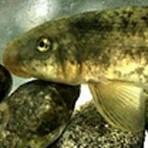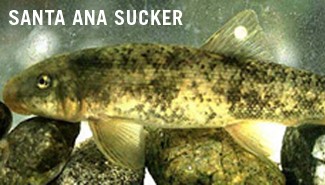
Inland water agencies may say they want to work with government regulators on a Santa Ana River habitat for a tiny fish known as the Santa Ana Sucker, but as long as the H2O providers press their lawsuit against the U.S. Fish and Wildlife Service, four conservation groups will press back. The Sierra Club, California Trout, the Center for Biological Diversity and the San
Bernardino Valley Audubon Society announced today they will defend the federal agency's “science-based designation of critical habitat for
the rare, unique Southern California fish” by intervening in the suit
filed by a dozen Southern California water agencies and towns.
]
Two years after the Fish and Wildlife Service (FWS) established a critical habitat area for the Santa Ana Sucker in 2005, a lawsuit was filed against the agency by the Center for Biological Diversity, which is based in Arizona but whose lead biologist works out of Los Angeles.

The conservation group, which based its suit on violations of the Endangered Species Act, won in court. So, the FWS in 2010 doubled to 9,331 acres along three Southern California rivers the critical habitat for the sucker, a small, olive-gray fish found
in clear, cool, rocky pools of creeks, as well as gravelly bottoms of
streams with slight to swift currents.
In August, water agencies serving nearly 3
million Southern California residents–Bear
Valley Mutual Water Company in Redlands; Big Bear Municipal Water District; City
of Redlands; City of Riverside; City of San Bernardino Municipal Water
Department; East Valley Water District in Highland; Riverside County Flood
Control and Water Conservation District; San Bernardino Valley Municipal Water
District; San Bernardino Valley Water Conservation District; Western Municipal
Water District in Riverside; West Valley Water District in Rialto; and Yucaipa
Valley Water District–filed their suit against FWS that, ironically, is also based on alleged violations of the Endangered Species Act and other federal laws.
More importantly, they claim, the expanded critical habitat area imposes new
restrictions on water conservation, groundwater recharge and flood
control operations along the Santa Ana River, which eventually dumps into the ocean off Orange County.
After months of waging a p.r. campaign against FWS, the coalition of water agencies seemed to have come up with a more conciliatory tone a few weeks back. A letter from top officials of Riverside Public Utilities, Western Municipal Water
District and San Bernardino Valley Municipal Water District was sent Sept. 20 to Jeff
Brandt, a senior environmental scientist for habitat planning at the
California Department of Fish and Game, and copied to FWS and the Riverside-Corona Resource
Conservation District.
“Our agencies would like to begin work immediately
with CDFG, the RCRCD, USFWS, and member agencies of the Santa Ana Sucker
Task Force and the Santa Ana Sucker Conservation Team to develop a
master plan for habitat restoration and recovery of native fishes in the
Santa Ana River and its chief tributaries,” read the letter.
“The master plan would identify potential
habitat restoration projects, potential sources of funding, and
otherwise chart a path toward the eventual recovery of these species.
The master plan would also identify standard mitigation measures for
construction projects that might be located in the Santa Ana River
channel or within one of these tributaries. Lastly, the master plan
would identify other avenues through which the participants could
cooperate to achieve our shared goal of restoring native fish
populations in the Santa Ana River.”
The first project would have $125,000 from a special fund of the San Bernardino Valley and Western
Municipal Water districts granted to the Riverside-Corona Resource Conservation District to restore the Santa Ana Sucker habitat within Riverside's Tequesquite Arroyo, where trash, other debris and non-native plants would be removed.
However, despite everyone just seeming to get along, the lawsuit remains in court. Thus, today's announcement from the four conservation groups.
[
“The Santa Ana Sucker is a barometer of the state
of its river,” say Ileene Anderson, the LA-based Center for Biological Diversity biologist, in a statement released by the groups. “The
current critical habitat for the sucker is not only the bare minimum
the species needs to survive–it's the bare minimum the river needs to survive.”
“We worked hard to force the government to use good
science–and not dirty politics–in this determination, and now we're
forced to go back to work to make sure the 2010 rule stays in place,”adds Nica Knite, California Trout's Southern California regional manager.
“The water agencies' lawsuit attacking the 2010
designation has nothing to do with the species and everything to do
with the unwillingness of the water agencies and developers to make
reasonable accommodations for this species,” chimes in the Sierra Club's Kim Floyd. “Protecting the Santa Ana sucker in its namesake river is
essential to protecting the whole river, and thus everybody's water
supply.”
Douglas Headrick, general manager of San Bernardino
Valley Municipal Water District and, truth be told, the point person in the multi-agency attack on the 2010 FWS habitat, claims it is that same water supply he is trying to protect.
“We'd like to see the Service work with
local agencies in a cooperative way to maximize conservation efforts to
nurture the Sucker without putting local water supplies in jeopardy or
increasingly our reliance on water imports from the Sacramento-San
Joaquin Delta,” he said recently. “We think the Service could
achieve a lot more of its objectives by working cooperatively with local
agencies.”
Previous coverage:
- Biologist Accuses Inland Water Districts of Spooking Populace Over Expanded Santa Ana Sucker Habitat

OC Weekly Editor-in-Chief Matt Coker has been engaging, enraging and entertaining readers of newspapers, magazines and websites for decades. He spent the first 13 years of his career in journalism at daily newspapers before “graduating” to OC Weekly in 1995 as the alternative newsweekly’s first calendar editor.

